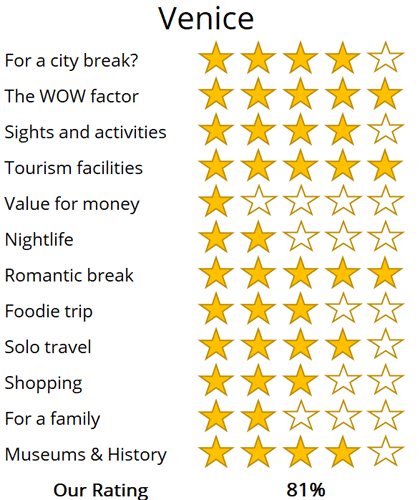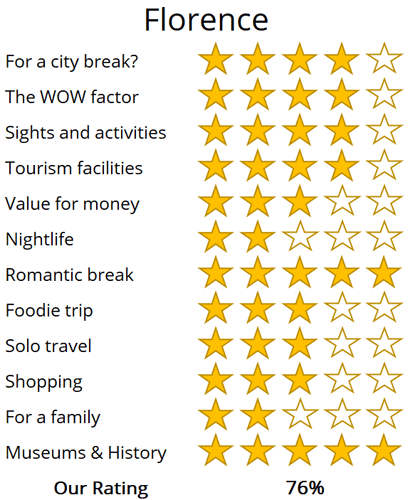WhereToGoForMyHoliday.com
The best destination comparison site!
WhereToGoForMyHoliday.com
The best destination comparison site!
Venice or Florence, which is better for your holiday in 2024?
Florence and Venice both offer unique and enticing experiences, but which one should you choose for your city break or holiday?
We understand your dilemma. There is an abundance of travel guides for both cities, but few actually comparing them, and advising you which is the better for your trip.
This article will provide our unbiased and independent views of Florence and Venice, hopefully making your choice that little easier.
The article is structured into several sections, each of which can be directly accessed through the following links:
• Introduction to the cities
• Scores and ratings
• Which one should I, friends, or family visit?
• When to visit and weather
• Who is the city suited for?
• The perfect 48hours (with map)
• Tourism details (where to stay? airport details?)
Introduction to Venice and Florence
Florence comes at you in a flurry of priceless art, pastel-painted jewellers, romantic piazzas, marble-gilded basilicas, and saffron-scented risotto. Nestled into the rolling Arezzo hills in the northern part of Tuscany, this is the very birthplace of the European Renaissance.
Florence flows in its 15th-century brilliance; there’s the Uffizi Gallery - home to works by Michelangelo and Sandro Botticelli - and the handsome Ponte Vecchio bridge.
Delve beneath the famed sights and Florence is a lived-in Italian metropolis. Locals devour lampredotto sarnies while glugging Chianti reds in hidden trattoria.
Florence’s allure is as classical as the city itself, but be warned you will be sharing the experience with many others, as there will be crowds!
Ah, Venice – a bucket-list city if there ever was one! Famed for its myriad canals, vast plazas and grand churches, this is one of Italy's most visited destinations.
Once the epicentre of its own trading empire that stretched right across the Mediterranean and even east to the Old Silk Road, it became rich on spices, precious metals, and cloth. These days, relics of that golden age remain. See them rise with the Orientalist spires of Saint Mark's Basilica. See them in the opulent interiors of the endless Doge's Palace.
But Venice is still a thriving town, not just a museum piece. Ferry boats weave through the Grand Canal and under arches where Canaletto and Monet once painted. Ice-cream parlours spill onto the narrow streets of Cannaregio. Pizzerias meet buzzy student bars scented with grappa around the Campo Santa Margherita. Yep, there's oodles of life left in this old seafaring dame!
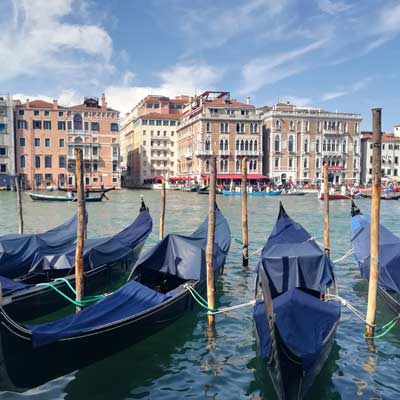
Grand Canal and gondolas waiting for the rush of tourists
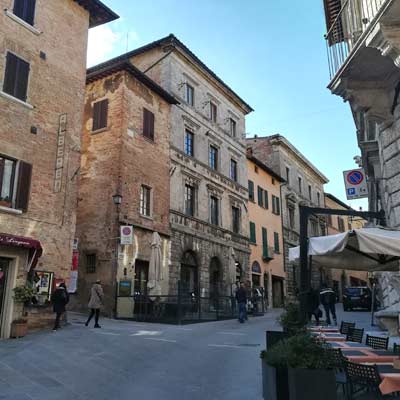
Every street in Florence is characterful
Venice VS Florence: City Ratings
Summary
Where would I journey for a personal escape?
Florence
Where would I send my parents for a memorable visit?
Florence
Where's the ideal destination for my adventurous 19-year-old cousin?
Florence
Where should my food-obsessed friend indulge their culinary passions?
Florence
Note: The above comparisons are weather-independent and are based on travel during the most opportune times of the year. Details about the ideal travel seasons are elaborated upon later in this article.
In the sections that follow, you'll find a comprehensive comparison between these two fascinating cities. This includes recommendations on the duration of stay, the best times to visit, and tailored 48-hour itineraries for each city.
The final segment delves into practicalities for your travels, such as the best airport to fly into, the optimal districts for your accommodation, and insider tips, for when you come to explore the city.
We hope that you find all of this information useful, in planning your next exciting trip!
Destination details
How long to spend each city?
It's no secret that most people whiz in and out of Venice on big cruise ships, even if recent regulations are bringing a slow end to that.
Lots of weekenders also come on low-cost flights – Venice's Treviso Airport is a major hub for budget airlines like Ryanair and Easyjet. Those sorts of travellers can only ever really expect to scratch the surface of what's on offer.
The upshot? If you really want to explore this amazing city, you're going to need a little longer. If the budget allows, a week is perfect. That will be enough to see the mainstay sights, but also venture across to Murano and the Venice Lido, the party bars of Campo Santa Margherita, and the pathways of Giudecca.
Florence demands at least two days. Lovers of this enchanting town will surely scoff at that. They wax lyrical about how Florence seduces folk who pass its way into staying weeks, months, years, and even whole lifetimes. Still, we think it's possible to check off the main sights, try the top dishes, and explore the historic center with around 48-72 hours total.
In the peak season there are extremely long queues for the galleries and Duomo cathedral; to avoid wasting precious time, it is advisable to pre-purchase tickets and start the day sightseeing very early (before 8am).
There are many good day trips from Florence, which are easily accessible by train, and include Siena, Lucca, and Arezzo. Florence may be a smaller city, but a fabulous one-week holiday could be had based here.

The Arsnal was the shipyard of Venice, which at its height could construct a boat in a single day
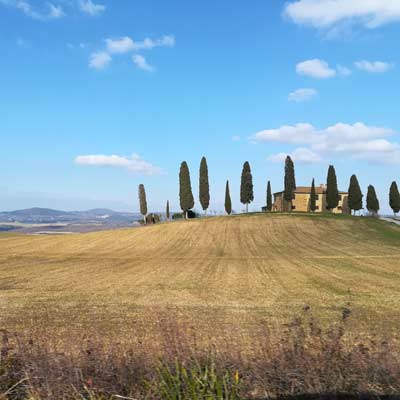
Tuscany is a beautiful region to discover
We're almost tempted to say forget Venice in the summer entirely. During the Italian high season between May and August, the whole place is packed to bursting with tourists. You can barely swing a slice of pizza on the Rialto Bridge or down on Piazza San Marco.
What's more, the horizon is tainted with the outlines of huge cruise ships.
Far better are the shoulder months of May and September. The crowds diminish considerably during those, but the weather still tends to be reasonable – think daytime temperatures regularly hitting the mid-20s.
The final weeks of February are also popular on account of the centuries-old tradition of the Venice Carnivale. Come then to join the revelry but be sure to bring along a flamboyant face mask (a must) and a good coat, because the winters can be cold.
It's probably a good idea to avoid the rest of the winter. Venice is one of the lowest-lying cities in the world, so flooding comes easy. In the last few years, there have been huge problems with water clogging up even the famous tourist hotspots around Piazza San Marco.
You've got to remember that Florence is up there with the most famous in Italy, and the vast majority of the 15.4 million visitors that come annually turn up in the summer months! That sends hotel rates skywards between June and August and means you'll need to jostle for space in front of Giotto's Bell Tower and the Duomo.
The ideal time to visit Florence is from April to June or September and October. They have good weather, fewer people, and cheaper prices, not to mention food festivals and wine harvest events. Winters are cooler and possibly wet but have the lowest number of tourists.
Culture and art are the pillars of Florence. Lovers of the late Middle Ages and the Renaissance will feel right at home between the Accademia Gallery and the Uffizi. Within their halls are iconic sculptures like Michelangelo's David, The Birth of Venus by Botticelli, and Caravaggio's haunting Medusa. And that's only scratching the surface!
Adding to the mix are the intriguing collections of the Museo Galileo for science buffs, the Ponte Vecchio for architecture aficionados, and tasty Tuscan farm foods for gourmands. Downsides include high visitor numbers, so it's best to steer clear if you're not a fan of crowds, particularly in the summer.
Florence is not an overly expensive destination, is relatively safe and has a small city atmosphere.
Venice is a perfect break for those keen to check off another bucket-list city. Yes, it might be over touristed, but there's still something truly magical about the canals and the gondolas and the great churches here.
It's simply unlike anywhere else on the planet. All that adds an edge of romance to boot. So, consider this one if you're searching for a city-based honeymoon.
On the flip side, Venice isn't for the budget traveller or the outdoorsy person. Yes, you can hop on a bus to go north to the Dolomites, but they are still several hours away.
There are beaches, but they are nowhere near the best on the Italian east coast. And you can expect to pay over the odds for virtually everything, from hotels to ice creams to pizza.
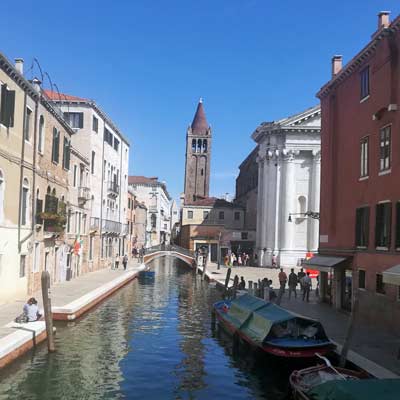
The pretty Ponte dei Sospiri and canals of Venice
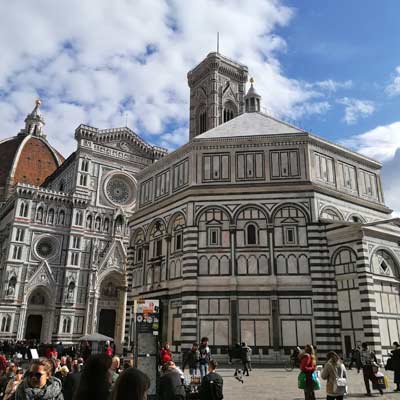
The Duomo has a gothic design, but the façade is covered in red green and white marble
48hours in Venice
Delve into the secrets and the uber-famous sights of Venice with this 48-hour itinerary. It will take you from the legendary walks of the Rialto Bridge all the way to the hidden glass workshops of Murano, revealing some of the most enthralling corners of the iconic City of Canals.
Day 1: Rise early and race to the Piazza San Marco. Beating the crowds to the vast plaza is a great way to see it in all its glory. As the sun rises, watch as the light caresses the red-brick Campanile (a 98-meter belfry dating from the 12th century) and the bulbous domes of St Marks Basilica.
If you've managed to arrive before the queues start to form, be sure to duck into the latter. It's free to enter and has intricate Byzantine apses and frescos. Right next door is the Doge's Palace. Again, if it's too late you can certainly expect a queue. If not, head behind the Gothic frontispiece to wander the old palace of the erstwhile leaders of the Venetian republic.
Then head north through the narrow alleys of the San Marco district. It's a beautiful maze of little side streets, occasionally punctuated by a watery canal. You're sure to find a cafeteria there for lunch, before you go straight for the Rialto Bridge, made famous by Shakespeare and painters. Cross it and hit the buzzing markets of Ruga dei Oresi, which abut the small Campo Bella Vienna, a top spot to sit with a cold beer and watch elegant Venetian gondolas drift in and out of the canals.
If you choose not to ride one, you can push on to see the San Giacomo di Rialto (probably the oldest church in the whole city!) and then the neighbourhood around Campo Santa Margherita. That's a nightlife mecca, where you can unwind with a prosecco or ten.
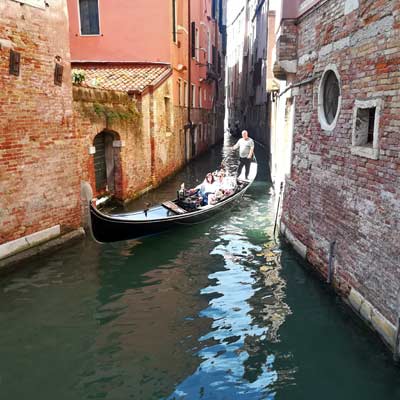
No trip to Venice is complete without a gondolas ride
Day 2: Your second 24 hours in Venice is all about hitting the different districts. We'd recommend starting on the northern side of the archipelago. That's home to characterful Cannaregio; the old Jewish Quarter. These days, it's got canal-side cafés next to the fascinating Muso Ebraico di Venezia, which tells the story of Venetian Jews over the centuries.
From there, move west to Santa Croce. Within, you'll glimpse the lived-in city. It's the only place where cars can travel on the archipelago and it has newer churches and loads of bakeries and shops. Hop the Grand Canal ferry (number 3) from there to Murano.
Pastel-painted workshops meet the water on that island, in an area that's been famed for centuries for its glass making. If you're interested, the Museum of Glass is a great place to start.
Alternatively, enjoy a lunch on the lagoon and then get back on the boat, travelling all the way through the Grand Canal to the Dorsoduro. The zone has beautiful broadside views of Piazza San Marco at sunset. It's also home to plenty of lovely osterias with northern Italian wines and delicacies to get stuck into.
Related articles: 48-hours in Venice

The vaporetti ferries are the best way to get a waterside view of Venice
48 hours in Florence
Early morningstarts are key in Florence, to hit the galleries and basilicas before the crowds. Don't worry, though, this two-day itinerary has time to rest with beautiful views in Renaissance gardens come the afternoon…
Day 1: Make for the Piazza del Duomo for the break of dawn – seriously, the earlier you can get there the better. That way, you can snap shots of the great cathedral and adjacent Giotto's Bell Tower without plumes of visitors getting in the way!
Look to the green-white marble inlays and the striking Gothic Revivalism of the whole building and think about hitting the 87-meter high lookouts of the belfry for some sweeping views across the city and the Apennines.
Traditional Tuscan design oozes from the lovely Palazzo Vecchio on Piazza della Signoria – this is the town hall, dating from way back in the 1400s. Grab an on-the-go pizza slice and make north to Galleria dell'Accademia after that.
A quick in and out there should be enough to appreciate the wonderful David statue by Michelangelo, before hopping back to the riverside and crossing the Ponte alle Grazie (have the camera ready).
For sunset, a climb to the Piazzale Michelangelo is a must. The panoramas include the Tuscan hills and the pastel-painted tops of the city, which look stunning as the light dips low.
For dinner try the regional meal of Bistecca alla Fiorentina (Florentine steak).

The shops along the Ponte Vecchio traditionally sold jewellery
Day 2: It's a museum morning in the famous Uffizi Gallery on day two. For art lovers, the journey here is a rite of passage. The collections span several wings of a great palace in the heart of central Florence and can take hours on end to appreciate fully.
Highlights that simply can't be missed include The Birth of Venus (Botticelli), Laocoön and his Sons (Bandinelli), Raphael's portrait of Pope Leo X, and Caravaggio's unforgettable Medusa. Back outside, the Ponte Vecchio bridge isn't far. It was once a butcher's market but is now famous for its jewellery boutiques.
On the hills beyond are the handsome Boboli Gardens, all brimming with babbling fountains and carved statues. Further up again is Forte di Belvedere, where even more breathtaking views of Florence are on offer come the evening.
Related articles: Florence in 2 days

The Uffizi Gallery exhibits the greatest collection of Renaissance art

The statue of David is regarded Michelangelo finest work
Florence
The best place to touchdown on a flight is surely Amerigo Vespucci International Airport. A mere 15 minutes' drive (7km) in a taxi, or 30 minutes in a train, can link you from the downtown to the terminals there.
Unfortunately, the bulk of Europe's budget carriers will jet into Pisa. That's still close – around 1-1.5 hours (83km) in the bus to the west.
Avoid flying into Bologna, as this is even further away (115km), and bus transfer 1.5-2 hours.
You definitely won't have to worry about finding somewhere to stay. From slick boutique hotels to simple hostels, Florence has all sorts. The town's primary industry is tourism, after all. Just expect prices to soar in the middle of the summer, before dropping again around the start of September.

The Piazza della Signoria
In terms of neighborhoods, you'll want to focus on bedding down within the SS67 ring road. More specifically, the districts of San Giovanni (the historic core) and Santa Croce are perhaps the most central, even if the latter retains a lived-in Italian feel. San Marco is a whisker to the north, hosting the bulk of the low-cost hotels and guest houses. Oltrarno boasts buzzy nightlife venues and hip coffee shops.
Related articles: Where to stay in Florence?
You probably won't need any forms of transport in Florence other than your own two feet. The town is eminently walkable. Be sure to bring comfy shoes that are suited to long days, however, especially if you're keen to scale to the lookout points around Piazzale Michelangelo.
For exploring the surrounding region, a rental car is a must. These tend to be cheap in Italy and are best organised from the airport to avoid driving through the centre of town.
Aside from the infamous Stendhal syndrome – a condition supposedly caused by exposure to too much beautiful Florentine art – there are no standout risks to visiting this city. The centre is generally safe and well maintained, crime rates are relatively low, and the locals are often happy to help out.
Venice is largely safe and easy to travel. However, there are some things worth knowing before you go. First off, the overload of tourists has seen a huge spike in pickpockets over the years. So, always keep an eye on your valuables, especially in uber-popular spots like the Piazza San Marco and Erbaria.
Second, be wary that Venice's side streets are rarely empty. You'll always need to dodge a crowd and watch where you're walking. When it rains, flooding is common, so pack waterproofs and wellies if you're visiting in the winter months. Also, keep an eye out for pigeons. They're a nuisance on the piazzas and can even carry disease.
Navigating Venice isn't like navigating any other place in Europe. Taxis and buses simply don't exist – there are no real roads here, after all. Instead, you can make use of the ferries (known locally as vaporetti).
They run routes up and down the Grand Canal and out to other islands like Murano all throughout the day. They're actually a great way to see the main sights, with tickets for a full 24 hours costing as little as €20.

Rarely will you find a steet this quiet in Venice……
There are two airports serving Venice and its region. The largest and the closest to town is the international hub at Marco Polo Airport. That's got connections going all around the world. It's linked to the city by the ATVO bus (arrives at Piazzale Roma) and to the train station in Mestre.
If you're flying low-cost, it's more likely you'll arrive at Treviso Airport. That sits some 20 miles to the north, with buses that link to the archipelago in around 70 minutes for about €10 each way.
Choosing where to stay in Venice is very important. Fly-in, fly-out tourists will want to be in the vicinity of Piazza San Marco. The area is laced with expensive and classy hotels, but also has some more affordable options, all within walking distance of the top sights.
If to save some cash and get somewhere a little quieter, you could sleep closer to Dorsoduro or the Cannaregio, or even out in Murano. The cheapest places of all will be on the mainland, in Mestre.
Related articles: Where to stay in Venice?

oh we were stuck in the airport!

Copenhagen was a bit expensive...

All we did was drink beer in Brussels...

Muncih was crazy

And we got so burnt!

Remeber that night in Rome

oh we were stuck in the airport

So much fun kayaking

Berlin and that group from Austria!

There was such a view from that church

And we got so burnt!

Munich was eventful, wasn't it!

Such a view from that cathedral in Florence

Lisbon was such so much fun

Last summer was so much fun .... x

Remeber that night in Rome

Lisbon was such so much fun

Such a view from that cathedral in Florence

Munich was eventful, wasn't it!

And we got so burnt!

Remeber that night in Rome

All we did was drink beer in Brussels...

Berlin and that group from Austria!

Can't wait to go back to Dubrovnik

Remember that boat ride in Prague

Copenhagen was a bit expensive...
